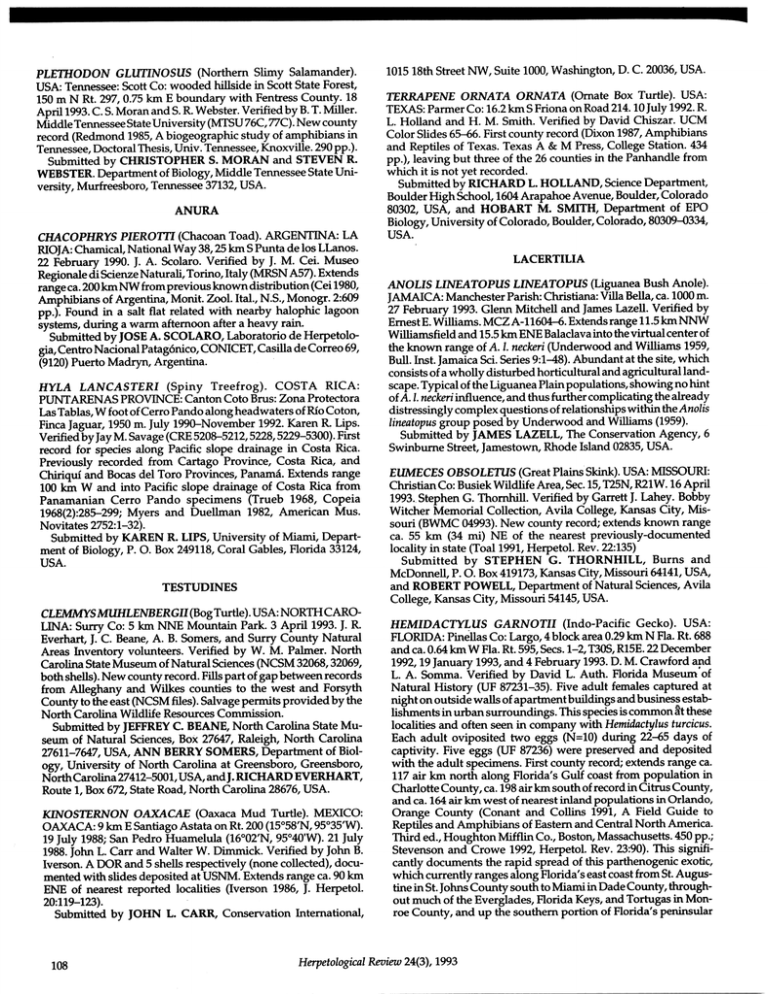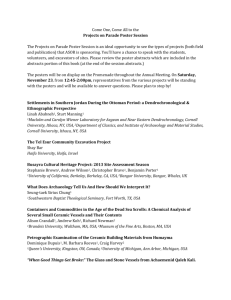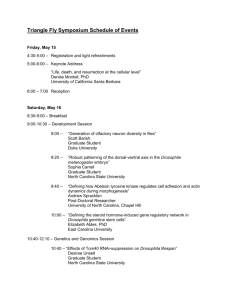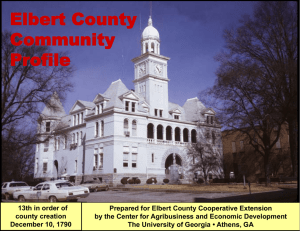1015 18th Street NW, Suite 1000, Washington, D. C. 20036,... PLETHODON GLUTINOSUS (Northern Slimy Salamander).
advertisement

PLETHODON GLUTINOSUS (Northern Slimy Salamander). USA: Tennessee: Scott Co: wooded hillside in Scott State Forest, 150 m N Rt. 297, 0.75 km E boundary with Fentress County. 18 April 1993. C. S. Moran and S. R. Webster. Verified by B. T. Miller. Middle Tennessee State University (MTSU 76C, 77C). New county record (Redmond 1985, A biogeographic study of amphibians in Tennessee, Doctoral Thesis, Univ. Tennessee, Knoxville. 290 pp.). Submitted by CHRISTOPHER S. MORAN and STEVEN R. WEBSTER. Department of Biology, Middle Tennessee State Uni versity, Murfreesboro, Tennessee 37132, USA. ANURA CHACOPHRYS PIEROTU (Chacoan Toad). ARGENTINA: LA RIOJA: Chamical, National Way 38,25 km S Punta de los LLanos. 22 February 1990. J. A. Scolaro. Verified by J. M. Cei. Museo Regionale di Scienze Naturali, Torino, Italy (MRSN A57). Extends range ca. 200 km NW from previous known distribution (Cei 1980, Amphibians of Argentina, Monit. Zool. Ital., N.S., Monogr. 2:609 pp.). Found in a salt flat related with nearby halophic lagoon systems, during a warm afternoon after a heavy rain. Submitted by JOSE A. SCOLARO, Laboratorio de Herpetologia, Centro Nacional Patagonico, CONICET, Casilla de Correo 69, (9120) Puerto Madryn, Argentina. HYLA LANCASTERI (Spiny Treefrog). COSTA RICA: PUNTARENAS PROVINCE: Canton Coto Brus: Zona Protectora Las Tablas, W foot of Cerro Pando along headwaters of Rio Coton, Finca Jaguar, 1950 m. July 1990-November 1992. Karen R. Lips. Verified by Jay M. Savage (CRE 5208-5212,5228,5229-5300). First record for species along Pacific slope drainage in Costa Rica. Previously recorded from Cartago Province, Costa Rica, and Chiriqui and Bocas del Toro Provinces, Panama. Extends range 100 km W and into Pacific slope drainage of Costa Rica from Panamanian Cerro Pando specimens (Trueb 1968, Copeia 1968(2):285-299; Myers and Duellman 1982, American Mus. Novitates 2752:1-32). Submitted by KAREN R. LIPS, University of Miami, Depart ment of Biology, P. O. Box 249118, Coral Gables, Florida 33124, USA. TESTUDINES CLEMMYSMUHLENBERGII (BogTurtle). USA: NORTH CARO LINA: Surry Co: 5 km NNE Mountain Park. 3 April 1993. J. R. Everhart, J. C. Beane, A. B. Somers, and Surry County Natural Areas Inventory volunteers. Verified by W. M. Palmer. North Carolina State Museum of Natural Sciences (NCSM 32068,32069, both shells). New county record. Fills part of gap between records from Alleghany and Wilkes counties to the west and Forsyth County to the east (NCSM files). Salvage permits provided by the North Carolina Wildlife Resources Commission. Submitted by JEFFREY C. BEANE, North Carolina State Mu seum of Natural Sciences, Box 27647, Raleigh, North Carolina 27611-7647, USA, ANN BERRY SOMERS, Department of Biol ogy, University of North Carolina at Greensboro, Greensboro, NorthCarolina 27412-5001, USA, and J. RICHARD EVERHART, Route 1, Box 672, State Road, North Carolina 28676, USA. KINOSTERNON OAXACAE (Oaxaca Mud Turtle). MEXICO: OAXACA: 9 km E Santiago Astata on Rt. 200 (15°58'N, 95°35'W). 19 July 1988; San Pedro Huamelula (16°02'N, 95°40'W). 21 July 1988. John L. Carr and Walter W. Dimmick. Verified by John B. Iverson. A DOR and 5 shells respectively (none collected), docu mented with slides deposited at USNM. Extends range ca. 90 km ENE of nearest reported localities (Iverson 1986, J. Herpetol. 20:119-123). Submitted by JOHN L. CARR, Conservation International, 108 1015 18th Street NW, Suite 1000, Washington, D. C. 20036, USA. TERRAPENE ORNATA ORNATA (Ornate Box Turtle). USA: TEXAS: Parmer Co: 16.2 km S Friona on Road 214.10 July 1992. R. L. Holland and H. M. Smith. Verified by David Chiszar. UCM Color Slides 65-66. First county record (Dixon 1987, Amphibians and Reptiles of Texas. Texas A & M Press, College Station. 434 pp.), leaving but three of the 26 counties in the Panhandle from which it is not yet recorded. Submitted by RICHARD L. HOLLAND, Science Department, Boulder High School, 1604 Arapahoe Avenue, Boulder, Colorado 80302, USA, and HOBART M. SMITH, Department of EPO Biology, University of Colorado, Boulder, Colorado, 80309-0334, USA. LACERTILIA ANOLIS LINEATOPUS LINEATOPUS (Liguanea Bush Anole). JAMAICA: Manchester Parish: Christiana: Villa Bella, ca. 1000 m. 27 February 1993. Glenn Mitchell and James Lazell. Verified by Ernest E. WiUiams. MCZ A-11604-6. Extends range 11.5 km NNW Williamsfield and 15.5 km ENE Balaclava into the virtual center of the known range of A. I. neckeri (Underwood and Williams 1959, Bull. Inst. Jamaica Sci. Series 9:1-48). Abundant at the site, which consists of a wholly disturbed horticultural and agricultural land scape. Typical of the Liguanea Plain populations, showing no hint of A. /. neckeri influence, and thus further complicating the already distressingly complex questions of relationships within the Anolis lineatopus group posed by Underwood and Williams (1959). Submitted by JAMES LAZELL, The Conservation Agency, 6 Swinburne Street, Jamestown, Rhode Island 02835, USA. EUMECES OBSOLETUS (Great Plains Skink). USA: MISSOURI: Christian Co: Busiek Wildlife Area, Sec. 15, T25N, R21W. 16 April 1993. Stephen G. Thornhill. Verified by Garrett J. Lahey. Bobby Witcher Memorial Collection, Avila College, Kansas City, Mis souri (BWMC 04993). New county record; extends known range ca. 55 km (34 mi) NE of the nearest previously-documented locality in state (Toal 1991, Herpetol. Rev. 22:135) Submitted by STEPHEN G. THORNHILL, Burns and McDonnell, P. O. Box 419173, Kansas City, Missouri 64141, USA, and ROBERT POWELL, Department of Natural Sciences, Avila College, Kansas City, Missouri 54145, USA. HEMIDACTYLUS GARNOTII (Indo-Pacific Gecko). USA: FLORIDA: Pinellas Co: Largo, 4 block area 0.29 km N Fla. Rt. 688 and ca. 0.64 km W Fla. Rt. 595, Sees. 1-2, T30S, R15E. 22 December 1992,19 January 1993, and 4 February 1993. D. M. Crawford and L. A. Somma. Verified by David L. Auth. Florida Museum'of Natural History (UF 87231-35). Five adult females captured at night on outside walls of apartment buildings and business estab lishments in urban surroundings. This species is common tt these localities and often seen in company with Hemidactylus turcicus. Each adult oviposited two eggs (N=10) during 22-65 days of captivity. Five eggs (UF 87236) were preserved and deposited with the adult specimens. First county record; extends range ca. 117 air km north along Florida's Gulf coast from population in Charlotte County, ca. 198 air km south of record in Citrus County, and ca. 164 air km west of nearest inland populations in Orlando, Orange County (Conant and Collins 1991, A Field Guide to Reptiles and Amphibians of Eastern and Central North America. Third ed., Houghton Mifflin Co., Boston, Massachusetts. 450 pp.; Stevenson and Crowe 1992, Herpetol. Rev. 23:90). This signifi cantly documents the rapid spread of this parthenogenic exotic, which currently ranges along Florida's east coast from St. Augus tine in St. Johns County south to Miami in Dade County, through out much of the Everglades, Florida Keys, and Tortugas in Mon roe County, and up the southern portion of Florida's peninsular Herpetological Review 24(3), 1993






